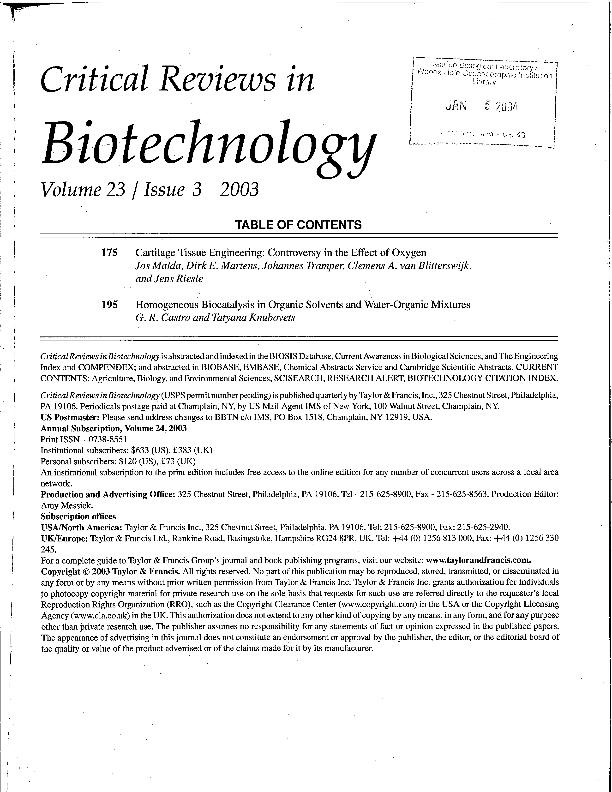Mostrar el registro sencillo del ítem
dc.contributor.author
Castro, Guillermo Raul

dc.contributor.author
Knubovets, Tatyana
dc.date.available
2018-04-13T18:50:10Z
dc.date.issued
2003-12
dc.identifier.citation
Castro, Guillermo Raul; Knubovets, Tatyana; Homogeneous Biocatalysis in Organic Solvents and Water-Organic Mixtures; Taylor & Francis; Critical Reviews In Biotechnology; 23; 3; 12-2003; 195-231
dc.identifier.issn
0738-8551
dc.identifier.uri
http://hdl.handle.net/11336/42020
dc.description.abstract
Biocatalysis in non-aqueous media has undergone tremendous development during the last decade, and numerous reactions have been introduced and optimized for synthetic applications. In contrast to aqueous enzymology, biotransformations in organic solvents offer unique industrially attractive advantages, such as: drastic changes in the enantioselectivity of the reaction, the reversal of the thermodynamic equilibrium of hydrolysis reactions, suppression of water-dependent side reactions, and resistance to bacterial contamination. Currently, the field is dominated by heterogeneous biocatalysis based primarily on lyophilized enzyme powders, cross-linked crystals, and enzymes immobilized on inert supports that are mainly applied in enantioselective synthesis. However, low reaction rates are an inherent problem of the heterogeneous biocatalysis, while the homogeneous systems have the advantage that the elimination of diffusional barriers of substrates and products between organic and water phases results in an increase in the reaction rate. Here the discussion is focused on the correlation between activity and structure of the intact enzymes dissolved in neat organic solvents, as well as modifications of natural enzymes, which make them soluble and catalytically active in non-aqueous environment. Factors that influence conformation and stability of the enzymes are also discussed. Current developments in non-aqueous biocatalysts that combine advantages of protein modification and immobilization, i.e. HIP plastics, enzyme chips, ionic liquids, are characterized. Finally, engineering enzymes for biotransformations in non-conventional media by directed evolution is summarized.
dc.format
application/pdf
dc.language.iso
eng
dc.publisher
Taylor & Francis

dc.rights
info:eu-repo/semantics/openAccess
dc.rights.uri
https://creativecommons.org/licenses/by-nc-sa/2.5/ar/
dc.subject
Homogeneous Biocatalysis
dc.subject
Organic Solvents
dc.subject
Enzyme Modification
dc.subject
Covalently Modified Enzymes
dc.subject
Coated Enzymes
dc.subject
Enzyme Stability
dc.subject
Reverse Micelles
dc.subject
Hydrophobic Ion Pairing
dc.subject
Directed Evolution
dc.subject.classification
Biología Celular, Microbiología

dc.subject.classification
Ciencias Biológicas

dc.subject.classification
CIENCIAS NATURALES Y EXACTAS

dc.title
Homogeneous Biocatalysis in Organic Solvents and Water-Organic Mixtures
dc.type
info:eu-repo/semantics/article
dc.type
info:ar-repo/semantics/artículo
dc.type
info:eu-repo/semantics/publishedVersion
dc.date.updated
2018-04-10T13:54:28Z
dc.journal.volume
23
dc.journal.number
3
dc.journal.pagination
195-231
dc.journal.pais
Reino Unido

dc.journal.ciudad
Londres
dc.description.fil
Fil: Castro, Guillermo Raul. Consejo Nacional de Investigaciones Científicas y Técnicas. Centro Científico Tecnológico Conicet - Tucumán. Planta Piloto de Procesos Industriales Microbiológicos; Argentina. Tufts University; Estados Unidos
dc.description.fil
Fil: Knubovets, Tatyana. Transkariotyc Therapies; Estados Unidos
dc.journal.title
Critical Reviews In Biotechnology

dc.relation.alternativeid
info:eu-repo/semantics/altIdentifier/doi/https://doi.org/10.1080/bty.23.3.195
dc.relation.alternativeid
info:eu-repo/semantics/altIdentifier/url/https://www.tandfonline.com/doi/abs/10.1080/bty.23.3.195
Archivos asociados
